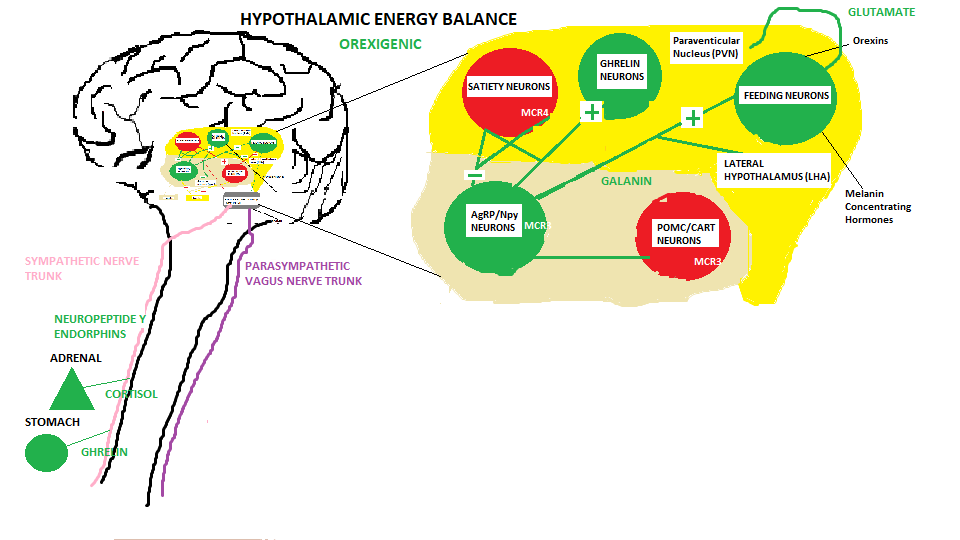Introduction
In the previous part (IV), we discussed the ANOREXIGENIC or Satiety regulation of homeostatic energy balance involving I/O signals to and from the satiety control centre, the Ventromedial nucleus (VMN). This centre relies on input from Leptin, Serotonin, Norepinephrine, Corticotropin releasing hormone (CRH), Insulin, Cholecystokinin (CCK), Glucagon like peptide (GLP), Peptide YY (PYY). Enterostatin and Oxyntomodulin (OXM). The various inputs are processed by specific anorexigenic neurons Proopiomelanocortin (POMC/CART) and other anorexigenic neurons located in the Paraventricular nucleus (PVN). Let us now discuss the antagonistic side of satiety, feeding.
Orexigenic hormones and neurotransmitters

Hormones/Neurotransmitters involved with OREXIGENIC Function – FEEDING
| Neurotransmitter/Hormone | Source |
| Neuropeptide Y (NPY) | Neurons in the sympathetic branch of the ANS |
| Agouti-related protein (AGRP) |
Orexigenic neuron in Hypothalamus |
| Melanin-concentrating hormone (MCH) | Neurons located in the LHA |
| Orexins A and B | Neurons located in the LHA |
| Endorphins | CNS & Pituitary gland |
| Galanin (GAL) | Hypothalamus & duodenum |
| Amino acids (glutamate and g-aminobutyric acid) | |
| Cortisol |
Adrenal gland |
| Ghrelin | Ghrelinergic cells located in the stomach and duodenum |
| Insulin like peptide 5 (ILP5) |
Orectic Peptides AGRP/NPY, and MCH
The orectic peptides stimulates appetite such as Neuropeptide Y (Npy) which is part of the central processing system for feeding located in the Arcuate nucleus ( ARC as shown in the diagram above as AGRP/NPY. This neuron complex is involved in carbohydrate metabolism increasing preference for carbohydrates. The other orectic peptide activated within this complex is Agouti related protein ( AGRP) and its role is to stimulate appetite and applying a soft break to slow down metabolism limiting energy consumption. The Melanin concentrating hormone MCH stimulates eating behaviour by glucose induced depolarization * of MCH neurons for neuronal activation. Glutamate has the same affect, and GABA cause MCH neurons to hyperpolarize*, while serotonin has the same affect and Cannabinoids** have an excitatory effect. These endocannabinoids which are products of adipocytes stimulate appetite through CB1 receptors in the Central Nervous System (CNS), causing the increase of adipose tissue, lowering the levels of adiponectin ( a protein hormone produced by adipose tissue that regulate glucose levels and fatty acid breakdown) and increases hepatic lipogenesis. Hepatic lipogenesis refers to the process of acetyl-Coa ( a molecule involved in fuel metabolism delivering an acetyl group to the krebs cycle for cellular energy production) conversion to fatty acid and triglyceride synthesis that becomes stored energy as fats. These products are packaged in VLDL (very low density lipoproteins) particles and secreted into the blood where they are transported to various tissues as an energy source.
*depolarization refers to a change in electrical potential resulting in a less negative charge (normal resting potential) inside the cell relative to the positive charge outside the cells referred to as the cell’s membrane potential. The polarity reversal is achieved by the movement of positively charged sodium ions ( NA+) out of the cell and replaced with positively charged potassium ions (K+) pumped into the cell using the millions of Sodium and Potassium pumps that reside within the cell membrane. This action basically causes transportation of substances in/out of the cell, and allows neurons and cells to communicate with each other using these electrochemical messages. Hyperpolarization drives the cell move negative thus inhibiting an action potential.
**Cannabinoids: When neurons send chemical messages( neurotransmitters) to each other , there is presynaptic cell that broadcasts the chemical substances across the neuron synapses to the receiver of postsynaptic cell. When the postsynaptic cell is activated it has the ability to control the amount of neurotransmission it receives by acting as a kind of dimmer switch to regulate the neurotransmission. This is where the endogenous cannabinoids come in, which are made from fat cells within the postsynaptic neuron that produce these ‘endocannabinoids’ that are sent back to the presynaptic neuron cannabinoid receptors enabling the control feature, regulating eating and sexual behaviour specifically in the hypothalamus. Endocannabinoids and their respective receptors exist in other parts of the brain and brain stem, e.g motivation and reward in the Nucleus Accumbens.
Neuropeptides Orexins (Hypocretins)
Two excitatory neurotransmitters (hypothalamic neuropeptides) was studied in 2002 by Rodgers at al, and the study that was named ‘Orexins and appetite regulation’ discovered in a mice model that these peptides stimulate appetite and behavioral processes concerning alertness and arousal. This suggests that these neuropeptides that are activated by severe nutritional depletion, allow the animal and human to seek sustenance as well as maintaining a high level of alertness to potential dangers within the environment; finding food and avoid being a meal for another predator. So the neurons are stimulated by the lack of food and a low level of glucose in the bloodstream, but they have a lower orectic effect than NPY and MCH.
Endorphins
In the articles ‘The destruction of society’s social fabric and antipsychotic drugs’ we covered the topic of endorphins which are the bodies natural opiates, in the context of pain management, however endorphins are also released in our natural reward circuits ( that we will cover in the next article ) that are activated by host activities like eating, drinking, exercise and sexual intercourse. Although normal endorphin release is associated with pain management they also an accompaniment when eating a pleasurable meal, and in some circumstances they help regulate appetite. Endorphins are polypeptides that are secreted by the CNS within the periaqueductal gray matter, shown in diagram 1, the Limbic system shown in diagram 2 below, and the spinal cord. Endorphins are also secreted by the anterior pituitary shown in diagram 3 under the control of hypothalamic neurohormones via the posterior pituitary through special portal blood vessels shown in the diagram as capillary beds
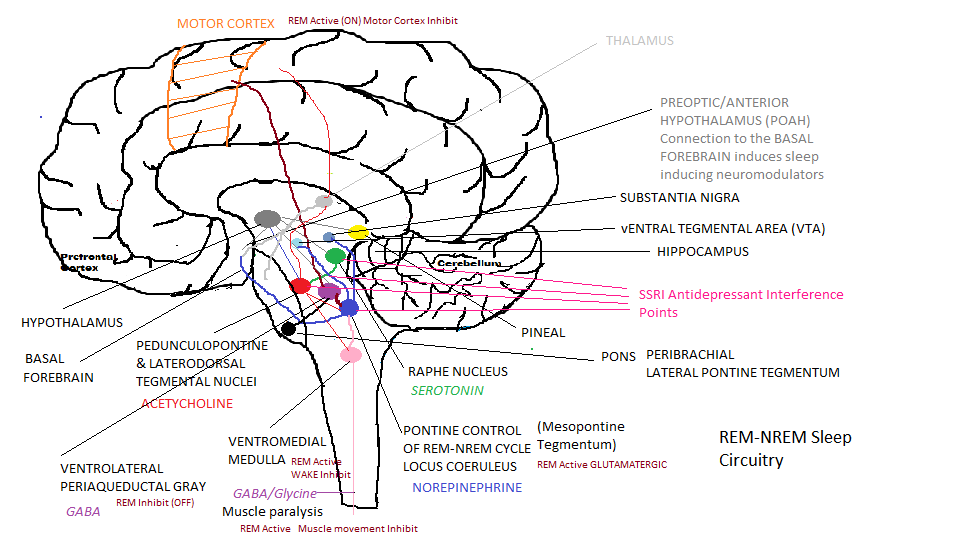
DIAGRAM 1 PERIAQUEDUCTAL GRAY
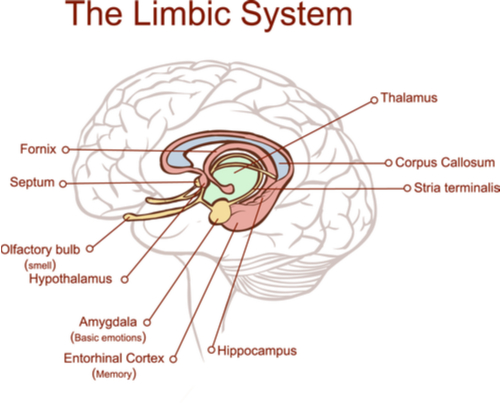
DIAGRAM 2 THE LIMBIC SYSTEM
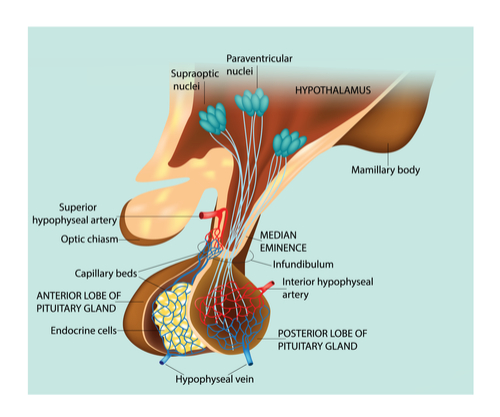
DIAGRAM 3 THE ANTERIOR PITUITARY
Galanin (GAL)
Galanin is a peptide that was first discovered in the gut where its receptors and signalling pathway is located in epithelial cells, smooth muscle, submucosal and myenteric neurons throughout the gut. The myenteric plexus nerve system provides motor innervation to the muscular layers of the gut providing gut motility from both branches of the Autonomic nervous system. The myenteric plexus is shown in diagram 4 below, providing the means to keep things moving, modulating motility and sphincters both stimulating and inhibiting. within the GI Tract, stimulated by various neurotransmitters including acetylcholine, dopamine and serotonin as well as Galanin. Galanin also stimulates intestinal chloride secretion to keep the mucosa hydrated and inhibits gastric acid secretion. In the hypothalamic feeding centre, GAL is expressed in many neurons located in the PVN, ARC and Dorsomedial nucleus ( next door to the PVN). GAL is also expressed in in the pituitary, pancreas, thyroid, and adrenal gland. Since the HPA stress axis has an involvement in the positive control of energy homeostasis and adipogenesis( production of adipocytes), the interaction of food regulating peptides including GAL has some relevance, as well as the release of adrenal glucocorticoid hormones. Finally, research shows that GAL has an inhibitory effect on insulin secretion from the pancreas
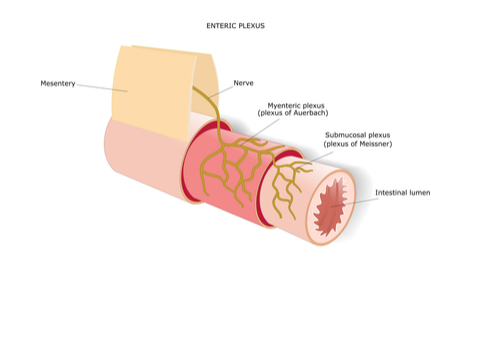
DIAGRAM 4 THE MYENTERIC PLEXUS
Ghrelin
I am afraid to say that research is far from complete when it comes to this hormone which we know is secreted predominantly from the stomach, triggered by hunger and conveying so to the hypothalamus, which in turn stimulates hunger. We also know that there is an antagonistic dance they ensues between it and Leptin which stimulates satiety, since it correlates its signalling with adipose fat mass. This is shown in diagram 5 Leptin and ghrelin relationship below.
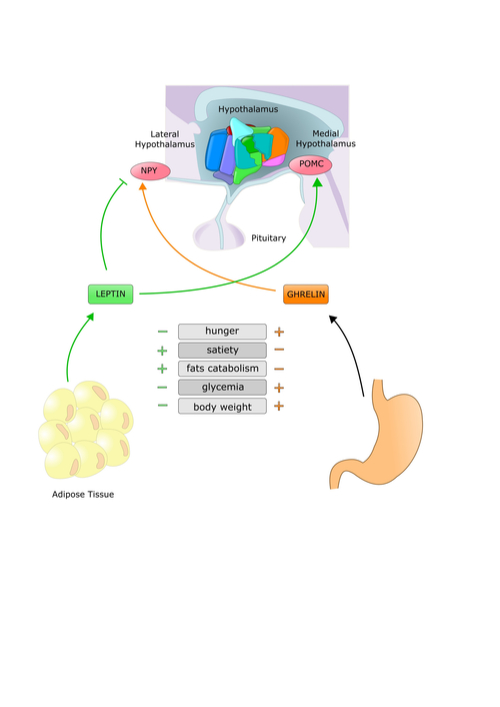
DIAGRAM 5 LEPTIN AND GHRELIN RELATIONSHIP
We know that ghrelin cells exist in the large and small intestinal tract, and we also know that this substance exists in the pancreas, where it plays an inhibitory role in terms of insulin and glucagon secretion, and an association with somatostatin ( growth hormone inhibiting hormone) that regulates the endocrine system, and also inhibits insulin and glucagon secretion, which apart from the pancreas, is also secreted in the duodenum and pyloric antrum ( the bottom of the stomach that empties into the duodenum). Studies in mice show ghrelin, when experimentally induced, triggers acute food seeking/intake behaviours and resulting chronic adiposity ( a novel term for obesity introduced by the American College of Endocrinology in 2016). Conversely, removing the ghrelin induction has a protective effect from diet induced obesity. A better understanding of ghrelin regulation is hampered by the interrogation of ghrelin cells that are scattered within the complex gastric mucosa. As stated before 80% of circulating ghrelin originates from gastric oxyntic mucosa ( mucous membrane layer of the stomach containing glands that produce mucus, pepsinogen, hydrochloric acid, intrinsic factor, gastrin, histamine and bicarbonate). Ghrelin is stimulated by oxytocin ( referred to as the ‘love hormone, since it enhances human hugging and orgasm), which is a peptide hormone, and neuropeptide, produced by the hypothalamic PVN, and released by the posterior pituitary, and dopamine. Finally Leptin binds to OB receptors within the hypothalamus which activates STAT3 gene that downregulates Endocannabinoids ( substances that activate cannabinoid receptors in the brain) that are responsible for increasing hunger.
Insulin like Peptide 5 (ILP5)
The Insulin like peptide family play a key biological role in the control of body growth. It is largely produced in the colon and is triggered by nutrient availability, however, how the body senses nutrient status and in turn regulate ILP production is not well understood.
Conclusions
It is quite clear that the homeostatic energy balance system is quite complex and there is still much to be discovered, for example, why both Ghrelin and Galanin inhibit insulin secretion, but the burning question is with this plethora of regulatory controls HOW DO PEOPLE BECOME OBESE ??. How are so many individuals able to bypass their natural physiological control circuitry made up of a variety of hormones and neurotransmitters It is suggested in Wikipedia that an ‘acute change’ in energy balance will change the dynamics of leptin signalling, changing its activation, based on appetite and food intake, as opposed to fat stores. What is this ‘acute change’?. This statement in my opinion is very plausible, since in Robert Pool’s book ‘Fat: fighting the obesity epidemic’ he mentions the body’s set point. As I stated in the articles on Metabolic typing the body initiates a set point and the body does not like to waiver too much away from it, so if you lose weight below the set point the weight regulation system ( energy balance) will kick in producing hunger so the host will make up the difference to achieve the set point again. This is the main reason why it is difficult to lose weight because you need to change the set point but the body does not want to.
Conversely, if the host gains weight, satiety signals will be initiated early to inhibit feeding. In obesity this set point has been moved, so satiety is established even though fat storage has increased to obese levels. Furthermore, the hypothalamus appears to ignore the multiple satiety signals even though fat mass leptin was triggered way before fast mass grew to obese levels. As Robert Pool states:
“ we are eating normally within an abnormal environment”
And as I state the brain has been taken prisoner by abnormal man made food engineered to saturate the reward centre and basically ‘bypass’ the weight regulation ( energy balance ) system that was originally designed for our hunter gatherer ancestors, that worked perfectly for them and their environment. Modern man has managed to drastically change the environment. Another intelligent response from the body is that leptin is pro-inflammatory, which makes sense since it needs to protect cellular stress in the adipose tissue brought on by overeating. In the next part of this series we will follow our investigation into the potential ‘Addiction centres’ of the brain known as the reward/hedonistic centres which I believe is where the root of the obesity problem resides and where the brain has been taken prisoner.
“If the present world go astray, the cause is in you, in you it is to be sought.”
Dante’s inferno
References/Acknowledgments :
- Serotonin: What it is and why it’s important for weight loss Judith Wurtman 2010 Psychology Today
- Norepinephrine and the control of food intake Wellman 2000 NCBI
- Melanocyte-stimulating hormones, incretins, Wikipedia
- Textbook of physiology Guyton & Hall 2006
- The Science of the Endocannabinoid System: How THC affects the brain and body Scholastic 2011
- Regulation of Energy Balance and body weight by the brain: A distributed system prone to disruption Lucy Faulconbridge & Matthen Hayes
- The pituitary is closely associated with the brain 2017 78 steps health journal: plasma membrane
- Galanin in the regulation of the hypothalamic pituitary-adrenal axis (Review) CINZIA TORTORELLA, GIULIANO NERI and GASTONE G. NUSSDORFER 2006
- Galanin and the endocrine pancreas Bo ahren et al 1988 Elsevier
- Chloride secretion by the intestinal epithelium: molecular basis and regulatory aspects Barrett & keely 2000 NCBI
- Ghrelin cells in gastrointestinal tract Sakata & Sakai 2010 International journal of peptides
- Postprandial inhibition of gastric ghrelin by long chain fatty acid through GPR120 in isolated gastric ghrelin cells and mice Xinping Lu et al 2012 NCBI
- Orectic and Anorectic peptides and their implication in obesity and the metabolic syndrome Alina Bodea & Amorin Remus Popa 2015 De Gruyter Bucharest Roumania
- Dante’s inferno quote Goodreads
Author: Eric Malouin
